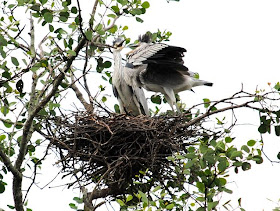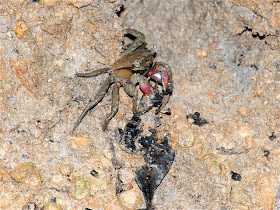It has been a long while since I have last visited Pasir Ris mangroves. So long that I couldn't even recall when was my previous visit. As such, I am glad to revisit this place while guiding with Naked Hermit Crabs.
There are several nests where you can spot herons from close distances and I arrived earlier to have a look at the grey herons. It began with these two juveniles chatting or quarreling with each other.
Until the mum/dad comes into the best to "play" with them... can you see that one of the juvenile's beak is actually over the adult's head? Not too sure what kind of behaviour is this haha!
And here's a nice photo of a family of three in one of the many nests in the area.
Before we started our walk, one of the participants spotted a rhinoceros beetle even before entering the mangroves! This bettle has a long horn that is used for fighting other males during mating season.
Soon, we formed our groups and I had the privilege of having a few families of young and not-so-youngs aka parents with me to explore the mangroves at Pasir Ris.
Soon, we formed our groups and I had the privilege of having a few families of young and not-so-youngs aka parents with me to explore the mangroves at Pasir Ris.
Ivan kindly pointed out a surprise within the foliage.... a huge bees' nest!
Here's a look at the gianormous nest from another angle! There sure was a lot of bees man.
Ivan later shared with me that this species of bees will actually do a "dance" similar to our kallang waves when disturbed. Of course we didn't hope for that to happen!!
On the lookout for the elusive mudskippers, my group participants spotted it first. And even after almost everyone else saw it, I still could not locate this well camouflaged fish till after say 10 minutes. Haha! Thanks all for trying so hard to point out to me, I feel so embarassed as a guide. :P
As we enter into the zonation closer to the river where more streams can be found, we saw a number of this Giant mudskipper. Most of them actually are victims to mosquitoes found in the mangroves.
There are lots and lots of crabs at Pasir Ris mangroves! These Tree climbing crabs with red pincers feed on leaf litter.
Here is a pair of the tree climbing crabs that were initially engaged in a fight.
What are these red dots on the mangrove ground? They are actually known as the Red berry snails (Assiminea sp.). Many were fascinated when I pointed out that these are actually snails. :)
While looking around from the boardwalk, this wasp was flying near a tree and landed for a while for us to take some nice photos. It sure is pretty!
Of course, there are also birds that rest and perch on the mangroves such as this Collared kingfisher that is known for their loud calls.
Ivan's group spotted this pair of horseshoe crabs which I will not notice as they are rather well camouflaged.
It is nice to know that National Parks Board has planted quite a number of these informative and attractive looking signboards along the way.
Even with conservation messages on how not to litter so as to do our part to keep our mangroves clean and alive.
Unfortunately though it is illegal to fish from the hut in the mangroves, we saw people laying lots of crab traps around. This is amongst the many threats that our shores and mangroves are facing.
Unfortunately though it is illegal to fish from the hut in the mangroves, we saw people laying lots of crab traps around. This is amongst the many threats that our shores and mangroves are facing.
All too soon, we escaped the rain and made it in time to the shelter for our drawing and colouring of our guestbook! The kids did a great job in this I must say!
Here is Emmanuel with his masterpiece- a boy who is very keen and interested in nature. I'm sure with more exposure, the kids will be more aware and hopefully also more active in spreading awareness of nature in Singapore. :)




















Here's a video of the giant honey bees doing the "wave".
ReplyDeletehttp://youtu.be/vll_2xH_SQY